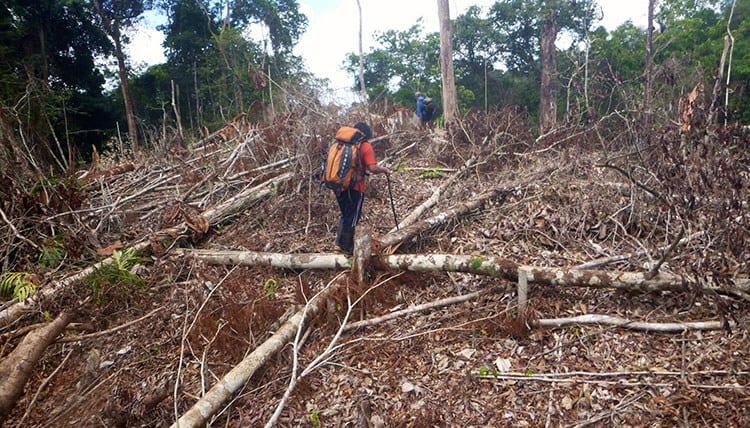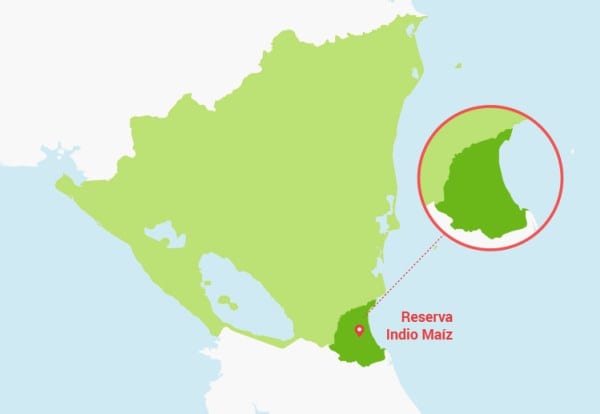Urgent plea to Save Nicaragua’s Indio Maiz Reserve
Rama-Kriol tribes point a finger at the government’s lack of action in the face of destruction
Wilfredo Miranda Aburto (Confidencial)

HAVANA TIMES – The sound of chainsaws echoes through the Indio Maíz Biological reserve in south eastern Nicaragua. Despite denunciations from the Rama-Kriol indigenous people and their documentation of the advance of illegal colonists into this jungle, the competent authorities and the government of Comandante Daniel Ortega “show no will” to stop it. These are the grievances expressed by Aldric Beckford Dearing, president of the Community Government of San Juan de Nicaragua [formerly known as Greytown] and Pablo Solano Ruíz, community forest ranger for the Indio Maíz Reserve.
These men describe a pattern that has been repeated throughout the indigenous territories of Nicaragua, be it in the Bosawás reserve or in the Miskito territories of the North Caribbean Coast. Community leaders have attempted to document with their own resources the destruction of the forests, but when they inform the authorities in hopes that they’ll act, they encounter only indifference.
The indigenous people have only five community forest rangers to cover two thousand square kilometers of the reserve. Solano Ruíz is one of them. When he’s requested assistance from the Ecological Battalion of the Nicaraguan Army he says that they “don’t what to accompany us.”
“We’re not doing very well in the community, because we find colonizers from different places. Two months ago we came across armed men and that’s a problem for the five of us. We feel alone,” expressed the indigenous forest ranger on the Esta Noche nightly news program.
These squatters are the bane of the indigenous territories. In their advance through the jungles they bring in cattle, chop down precious hardwoods, practice uncontrolled agriculture and end up in land trafficking schemes. Functionaries linked to the Sandinista Front have been implicated in the latter, according to a previous investigation in Confidencial.
Rule 445 (of the “Regulatory Law for Governing the Communal Property of the Indigenous Peoples and Ethnic Communities of the Atlantic Coast Autonomous Regions and the Bocay, Coco, and Indio y Maíz Rivers) establishes a juncture for healing. That is – to put things in order and expel the colonizers. Nevertheless, the indigenous people report a lack of support from the Ortega government.

“It concerns us that institutions such as MARENA (Ministry of the Environment and Natural Resources), the army and the Attorney General’s office – the ones responsible for carrying out and supporting the indigenous peoples with the healing process, and of implementing that legal framework – aren’t doing so,” Beckford Dearing stated regretfully. “As a territorial government everything we’ve achieved is thanks to our own resources,” he added.
Like the Rama-Kriol communities, several Miskito indigenous leaders have “assembled their own” resources to make an inventory of the number of colonizers occupying their territories. In the case of Beckford Dearing, they’ve carried out a diagnostic study and proposed to the colonizers a “system of peaceful coexistence” without affecting the ancestral culture. They tried to involve the National Commission for Land Demarcation and Deeds (CONADETI) in that effort, but without success.
“We’ve invited the institutions to sit down and elaborate together a strategy for defense from this invasion that impacts us. We’ve tried to create a cross-institutional plan, but even though we put up the economic resources for the effort so that they could add their weight, they don’t join in,” Beckford Dearing sustained.
The president of the Greytown Communal Government, a territory that includes nine communities, told us that they’ve had contact with Hernan Estrada, Attorney General of the Republic and the one responsible for following up on this issue. They’ve tried to move forward with his office, but have received no response. Confidencial also received no response from the Attorney General’s office, despite the fact that they promised to grant an interview over a month ago.
“When the President awarded us the title for our property, his first words were to respect the rights of the indigenous peoples. But I ask myself if the honorable president is aware of what’s happening,” Beckford Dearing stated. “Because the institutions that should be protecting the Indio Maíz reserve are not following through.”
Solano Ruíz, the forest ranger, stated that they patrol the Indio Maíz reserve twice a month and present the collected information in an indexed report to the authorities; therefore, he asserts, they can’t claim to be unaware. To Beckford Dearing, it’s a matter of “lack of will.”
Last year, the Rama-Kriol indigenous people tried to put together an inter-institutional meeting with the Attorney General, the Ministry of the Environment, and the political secretaries of Bluefields and Río San Juan. They met with them in Managua in the office of the Vice-President, but two days prior to the scheduled institutional arrival to Greytown, they cancelled the trip, Beckford Dearing declared.
“We met with Johnny Hodgson, political secretary of Bluefields, with the political secretary of Río San Juan, (,,,) and we suggested holding meetings with the authorities of the South Caribbean Coast and Río San Juan…we activated that interconnection, but then they cancelled. This worries us. The ministers of each institution and the political secretaries know about it. What else can we do? We call on President Ortega to issue instructions to save the Indio Maíz reserve, the indigenous leader demanded.
